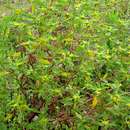Comments
provided by eFloras
Flaveria trinervia is widespread and weedy; it often occurs in saline, gypseous, disturbed areas near permanent or ephemeral water sources in southern Florida and from Texas to southern California. It occurs also in scattered locations in some eastern states and has been reported from Alabama.
The heads of Flaveria trinervia, which usually contain just one floret, are either radiate or discoid; radiate heads tend to occur on the periphery of setose glomerules. Reduction of some of the floral features, including number of florets [0–1(–2)], phyllaries per head (2), and size of ray laminae, suggest that F. trinervia may be the most derived species in the genus.
- license
- cc-by-nc-sa-3.0
- copyright
- Missouri Botanical Garden, 4344 Shaw Boulevard, St. Louis, MO, 63110 USA
Description
provided by eFloras
Annuals, to 200+ cm (delicate or robust, glabrate or glabrous). Stems erect. Leaves petiolate (proximal, petioles 10–20 mm) or sessile (distal); blades lanceolate or oblanceolate to elliptic or subovate, 30–150 × (7–)10–40 mm, bases (distal) connate, margins serrate, serrate-dentate, or spinulose-serrate. Heads 30–300+, in tight, axillary, sessile glomerules (receptacles of glomerules setose). Calyculi 0. Involucres oblong and cylindric or angular, 3.8–4.5 mm. Phyllaries usually 2, oblong (closely investing and falling with mature cypselae). Ray florets 0–1; laminae pale yellow or whitish, oblique or suborbiculate, 0.5–1 mm. Disc florets 0–1(–2); corolla tubes 0.5–1.4 mm, throats campanulate, 0.5–0.8 mm. Cypselae oblanceoloid to subclavate, 2–2.6 mm (rays longer); pappi 0. 2n = 36.
- license
- cc-by-nc-sa-3.0
- copyright
- Missouri Botanical Garden, 4344 Shaw Boulevard, St. Louis, MO, 63110 USA
Synonym
provided by eFloras
Odera trinervia Sprengel, Bot. Gart. Halle, 63. 1800
- license
- cc-by-nc-sa-3.0
- copyright
- Missouri Botanical Garden, 4344 Shaw Boulevard, St. Louis, MO, 63110 USA
Derivation of specific name
provided by Flora of Zimbabwe
trinervia: 3-veined
- license
- cc-by-nc
- copyright
- Mark Hyde, Bart Wursten and Petra Ballings
- bibliographic citation
- Hyde, M.A., Wursten, B.T. and Ballings, P. (2002-2014). Flaveria trinervia (Spreng.) C. Mohr Flora of Zimbabwe website. Accessed 28 August 2014 at http://www.zimbabweflora.co.zw/speciesdata/species.php?species_id=160760
- author
- Mark Hyde
- author
- Bart Wursten
- author
- Petra Ballings
Description
provided by Flora of Zimbabwe
Much-branched erect or procumbent annual herb, usually up to 75 cm tall, rarely taller. Branches opposite, often pinkish-red, mostly hairless. Leaves opposite, yellowish-green, narrowly elliptic to oblanceolate, 1-7.5 cm long, 3-veined from the base, narrowing at the base into a pseudo-petiole; margin more or less finely toothed. Capitula numerous in congested axillary and terminal heads, yellow with very short ray-florets, 0.5-1 mm long.
- license
- cc-by-nc
- copyright
- Mark Hyde, Bart Wursten and Petra Ballings
- bibliographic citation
- Hyde, M.A., Wursten, B.T. and Ballings, P. (2002-2014). Flaveria trinervia (Spreng.) C. Mohr Flora of Zimbabwe website. Accessed 28 August 2014 at http://www.zimbabweflora.co.zw/speciesdata/species.php?species_id=160760
- author
- Mark Hyde
- author
- Bart Wursten
- author
- Petra Ballings
Worldwide distribution
provided by Flora of Zimbabwe
Native to tropical America. Now a pantropical weed.
- license
- cc-by-nc
- copyright
- Mark Hyde, Bart Wursten and Petra Ballings
- bibliographic citation
- Hyde, M.A., Wursten, B.T. and Ballings, P. (2002-2014). Flaveria trinervia (Spreng.) C. Mohr Flora of Zimbabwe website. Accessed 28 August 2014 at http://www.zimbabweflora.co.zw/speciesdata/species.php?species_id=160760
- author
- Mark Hyde
- author
- Bart Wursten
- author
- Petra Ballings
Comprehensive Description
provided by North American Flora
Flaveria trinervia (Spreng.) C. Mohr, Contr. U. S. Nat. Herb
6: 810. 1901.
Oedera trinervia Spreng. Bot. Gart. Halle 63. 1800. Brotera Conlrayerba Spreng. Jour. Bot. Schrad. 1800'-': pi. 5.
1807. Nauenbergia trinervata Willd. Sp. PI. 3: 2393. 1804.
1801. Not Flaveria Conlrayerba Pers. Brolcra trinervata Pers. Syn. PI. 2: 498. 1807. Flaveria repanda Lag. Gen. & Sp. Nov. 33. 1816. Brotera Sprengelii Cass. Diet. Sci. Nat. 34: 306. 1825. Flaveria trinervata Baillon, Hist. PI. 8: 55. L882.
A dichotomously and divaricately branched annual; stem erect, 3-12 dm. high, sometimes tinged with red, glabrate; leaves connate, lanceolate, 3-nerved, serrate, 3-9 cm. long, the lower short-petioled; cymes congested and head-like, 2 2.5 cm. broad, axillary, subtended by three pairs of leaves; heads small, usually 1 -flowered, the flower either subligulate and pistillate or regular and hermaphrodite; involucral bracts concave, 1 or 2, if the latter, the outer shorter; corolla of the pistillate flowers 1.5 mm. long, the ligule oblique, 3-dentate; corolla of the hermaphrodite flowers 2 mm. long; tube villous; throat campanulate; achene 2 mm. long, somewhat clavate; pappus wanting.
Type locality: Botanical garden, Halle (cultivated).
Distribution: Alabama to Arizona, Oaxaca, and Yucatan; Cuba; also in South America. Introduced at Westford, Massachusetts.
- bibliographic citation
- Per Axel Rydberg. 1915. (CARDUALES); CARDUACEAE; HELENIEAE, TAGETEAE. North American flora. vol 34(2). New York Botanical Garden, New York, NY
Flaveria australasica
provided by wikipedia EN
- license
- cc-by-sa-3.0
- copyright
- Wikipedia authors and editors
Flaveria australasica: Brief Summary
provided by wikipedia EN
Flaveria australasica is an Australian plant species of yellowtops within the family Asteraceae. It has been found in New South Wales, Queensland, South Australia, Western Australia, and Northern Territory.
Flaveria australasica is very similar and possibly closely related to F. trinervia. Some authors treat the two as distinct species while others consider F. australasica as a synonym of F. trinervia.
- license
- cc-by-sa-3.0
- copyright
- Wikipedia authors and editors

